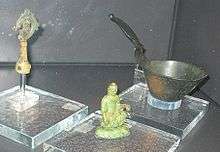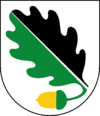Ekerö Municipality
| Ekerö kommun | ||
|---|---|---|
| Municipality | ||
| ||
 | ||
| Country | Sweden | |
| County | Stockholm County | |
| Seat | Ekerö | |
| Area[1] | ||
| • Total | 383.61 km2 (148.11 sq mi) | |
| • Land | 217.68 km2 (84.05 sq mi) | |
| • Water | 165.93 km2 (64.07 sq mi) | |
| Area as of January 1, 2014. | ||
| Population (June 30, 2016)[2] | ||
| • Total | 27,120 | |
| • Density | 71/km2 (180/sq mi) | |
| Time zone | CET (UTC+1) | |
| • Summer (DST) | CEST (UTC+2) | |
| ISO 3166 code | SE | |
| Province | Uppland | |
| Municipal code | 0125 | |
| Website | www.ekero.se | |
| Density is calculated using land area only. | ||
Ekerö Municipality (Ekerö kommun) is a municipality in the province of Uppland in Stockholm County in east central Sweden. The name derives from the name of the main island within the municipality whose name is Ekerön, and literally means "Oak Island". Its seat is located in the town of Ekerö.
Even if the City of Stockholm is the official capital of Sweden, the king of Sweden actually lives in Ekerö Municipality, at Drottningholm Palace (see below).
Ekerö is the only municipality in the Lake Mälaren region composed exclusively of islands. Land elevation has reduced the number of islands and skerries to 140, the largest of which, distinguished on the map below, are Adelsö, Munsö, Ekerö, Färingsö, and Lovö. 2000 years ago, during the Roman Iron Age, Färingsön was more of an archipelago of twenty islands.[3]
Originally, when the first local government acts were implemented in Sweden in 1863, eight rural municipalities were created, each corresponding to an old parish. The municipal reform of 1952 grouped them in two new larger entities. The next reform in 1971 merged them into the present municipality.

Heritage
The municipality contains two UNESCO World Heritage Sites. One is Birka, an old Viking Age village, and the other is Drottningholm Palace and its surroundings.

Drottningholm, located on the Lovö island, was originally a Renaissance palace built by King John III for Queen Catherine Jagellon. On the 30th of December 1661 the old palace burned down. Queen Dowager Hedvig Eleonora had a new palace erected out of the preserved walls and cellar vaults from King John III:s palace in the French Baroque style to the design of architect Nicodemus Tessin the Elder, a work later completed by Nicodemus Tessin the Younger, Carl Hårleman, and Jean Eric Rehn. Since 1981 it is the permanent residence of the royal family, but large parts of the park are accessible to the public. The palace features several uniquely preserved structures, including the Palace Theatre, inaugurated in 1766 and still delivering operas using the preserved original machinery; and the Chinese Pavilion, the Rococo design of Carl Fredrik Adelcrantz filled with Chinese luxury delivered by the Swedish East India Company.[3]

Birka on the Björkö island is the oldest urban structure in Sweden, founded in the mid 8th century. In the 9th century, Ansgar, Archbishop of Hamburg-Bremen, made two failed attempts to convert its inhabitants. The settlement was finally abandoned in the late 10th century for unknown reasons. The excavations of the approximately 1.100 graves in the area started in 1871 and have continued since. A museum was created in 1995, and in summers various boats carry large numbers of tourists to the island.[3]
Other notable historical sites
Other historical sights of interest are several runestones and other Viking remains, eight medieval churches, and old towns.

.
On the Adelsö Island is Hovgården, together with Birka a world heritage site, featuring barrows, thick walls, and runestones. There is also Alsnö hus, the ruins of the summer residence of Magnus Barnlock were the Ordinance of Alsnö created the foundation of the Swedish nobility, and a Romanesque church from the 12th century.[3]
Next to this Crown palace is the residential area Drottningholmsmalmen ("Drottningholm Ridge/Esker") which draws its history back to the Torvesund manor built in 1579-80 and which served as a place of refuge for the Jesuits following the Reformation. During the 18th century, soldiers, carpenters and other craftsmen working at The Royal Palace settled in the area. Intentions were to develop it into a suburb to the palace like at the Versailles Palace, and this end the area was granted the status of a city to attract entrepreneurs and artists to the royal court. During the reign of King Gustav III had several building erected, including the Långa raden (the "Long Row") to accommodate the royal body guard. By 1815 78 properties existed in the area. However, it failed to develop in the direction sketched-out by Gustav III, and instead evolved into a summer residence area inhabited by wealthy burghers, the large-scales villas in a wide range of styles have given the area its characteristics. In the middle of the 20th century several buildings by well-known Swedish architects, including Nils Tesch, Ralph Erskine, Peter Celsing and Bengt Lindroos, were added.[4]
Kanton is a group of twenty buildings next to the Chinese Pavilion built in the 1750s and 1760s, intended to be a mercantile prototype settlement. 70-80 people lived there for a few decades producing luxury items for the royal court and the nobility, including some of the interior of the China Pavillin.[5] The buildings later inspired author Elsa Beskow to some of her fairy tales.[3]
Kungshatt ("King's Hat") is a rocky island south of Lovön where, according to a legend, a king Erik Väderhatt ("Eric Weather Hat"), so named because of his fortune with the winds which he could foretell with his hat, escaped his enemies by jumping from the cliff with his horse. The location for this event was furnished with a copper hat, now substituted with an iron hat.[3]

Svartsjö Palace was originally a Folkung mansion. The palace King Gustav I and his sons had built here was destroyed by fire in 1687. The rococo palace, built 1735-39 to the design of Carl Hårleman and later expanded by Queen Louisa Ulrika, was neglected for centuries before being restored. Its Baroque and English gardens are preserved.[3]
Hilleshög Church is a mostly Romanesque edifice, built in granite and brick, with some parts from the 17th and 18th centuries and later additions. Many of the paintings in the interior, dating back to the end of the 13th century and the early 15th century, were painted over in the 18th century but were restored in the 1920s and in 2002, together with some of the furniture.[6]
Ekebyhov is a real estate created around 1630. Its main building, Ekebyhov Palace, is a wooden structure begun in 1674 and completed in 1704. It is the oldest preserved wooden palace in Europe. The gardens of the palace boasts several unique plants and features a café. It is since 1980 owned by the municipality.[7]
Skytteholm is a seat farm. Its main building, Skytteholm Mansion, was one of the mansions Johan Skytte, mentor of Gustavus Adolphus the Great, had built in the Lake Mälaren region. Founded in 1631, its present appearance is mostly from around 1920. It is today mostly used for conferences.[3]

In the 1950s, ancient remains were found on the island of Helgö. The excavations that followed unveiled eight groups of buildings and objects from Ireland, Egypt, and India dating back to the 8th century offering a hint of the extent of the trade of the era. The settlement is, however, believed to be considerably older and have reached its peak around 500-600 CE.[3] On Helgö is also the Kaggeholm Palace, with a history stretching back to 1370. The palace was built in the 1720s.[8]
The Barrow of Björn Ironside on Munsö Island is part of the Iron Age grave field Munsö-Husby. On Munsö is also Munsö Church; one of three round churches in the Stockholm area. Probably built in 1187, it contains several medieval wooden sculptures.[3]
Nature
There are several outdoor activities that can be enjoyed, such as fishing and bicycling, as the nature is always nearby. Each of the islands also offers distinctive experiences and sights.
Public transport
Ekerö is served by the Stockholm public transport system. All bus routes have connection with the Stockholm metro at Brommaplan.
Roads
The county road 261 offers connection to motorists from Brommaplan and other western suburbs of Stockholm. There is only one bridge connecting the municipality with the mainland, but there is also a car ferry taking motorists to Botkyrka Municipality south-west of Stockholm.
See also
| Wikimedia Commons has media related to Ekerö. |
Notes
- ↑ "Statistiska centralbyrån, Kommunarealer den 1 januari 2014" (Microsoft Excel) (in Swedish). Statistics Sweden. Retrieved 2014-04-18.
- ↑ "Folkmängd i riket, län och kommuner 30 juni 2016" (in Swedish). Statistics Sweden. August 17, 2016. Retrieved August 17, 2016.
- 1 2 3 4 5 6 7 8 9 10 Tynderfeldt
- ↑ Sundström
- ↑ Stockholm County Museum, Lovön - Drottningsholmsområdet
- ↑ Wallström
- ↑ Ekerö Municipality, Ekebyhovs slott
- ↑ Kaggeholm folkhögskola
References
- Tynderfeldt, Bo (1997). Mälaren runt (in Swedish). Utbildningsförlaget Brevskolan. pp. 86–92. ISBN 91-574-4829-9.
- Sundström, Lisa (2006). "Drottningholmsmalmen" (PDF) (in Swedish). Stockholm County Museum. Archived from the original (PDF) on 2008-04-09. Retrieved 2008-03-03.
- "Lovön - Drottningsholmsområdet" (in Swedish). Stockholm County Museum. Archived from the original on May 3, 2007. Retrieved 2008-03-03.
- Wallström, Eva (2002). "Hilleshögs kyrka" (PDF) (in Swedish). Stockholm County museum. Archived from the original (PDF) on 2008-04-09. Retrieved 2008-03-03.
- "Ekebyhovs slott" (in Swedish). Ekerö Municipality. 2007-11-22. Retrieved 2008-03-03.
- "Kaggeholms slott" (in Swedish). Kaggeholms folkhögskola. Archived from the original on September 23, 2008. Retrieved 2008-03-03.
External links
- Ekerö Municipality - Official site
Coordinates: 59°17′N 17°48′E / 59.283°N 17.800°E
